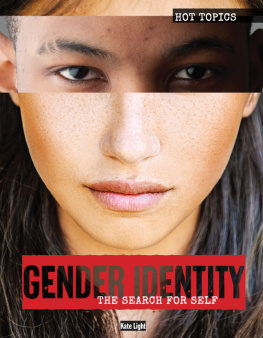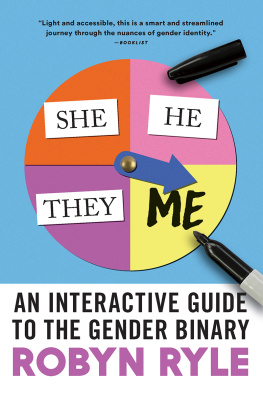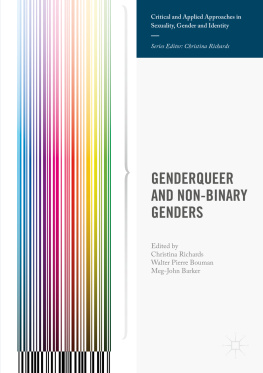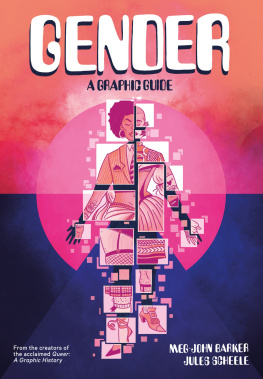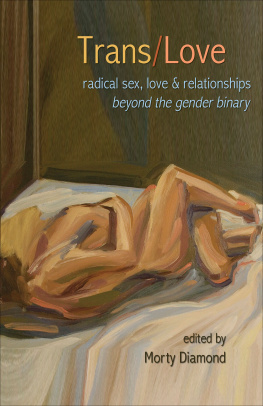Cover Image Zamurovic Photography/Shutterstock.com
Text P.M. Biswas 2021
First published by Luna Press Publishing, Edinburgh, 2021
Gendering Time, Timing Gender 2021. All rights reserved. No part of this publication may be reproduced, stored in a retrieval system, or transmitted in any form or by any means, electronic, mechanical, photocopy, recording or otherwise, without prior written permission of the copyright owners. Nor can it be circulated in any form of binding or cover other than that in which it is published and without similar condition including this condition being imposed on a subsequent purchaser.
www.lunapresspublishing.com
ISBN-13: 978-1-913387-36-5
INTRODUCTION
A Journey Through Time and Gender
I eliminated gender to find out what was left. Whatever was left would be, presumably, simply human.
Ursula K. Le Guin, Is Gender Necessary? Redux.
Topic and Scope
Gendering Time, Timing Gender: The Deconstruction of Gender in Time Travel Fiction is a book that investigates how time travel has been used to deconstruct gender and sex in speculative fiction. Specifically, it investigates how the dismantling of the past/future binary is utilised in the dismantling of the male/female gender binary in three different time travel narratives: Orlando by Virginia Woolf, All You Zombies by Robert A. Heinlein, and The Unintentional Time Traveler by Everett Maroon.
All three works feature protagonists whose gender identities are inextricably bound with time itself. As they move through time, their sex and gender identity changes. Time and gender are depicted as non-binary, with society imposing a socially-constructed binary on what transcends binaries altogether. The narratological shifts involved in the representation of time travel create a deconstructive counter-dialogic against heteronormativity that resists and gradually, subversively, erodes not only the temporal binary opposition of past and future, but also the heteronormative binary of male and female.
In The Unintentional Time Traveler and Orlando , time travel naturalises the process of gender change, with the passage of time to the past and to the future transforming the protagonist into another gender and into another sex. In the short story All You Zombies, the destabilisation of temporal continuity disrupts the protagonists gender continuity, and aids in the readers suspension of disbelief that such disruptions can occur.
All three narratives begin from the perspective of a seemingly heterosexual, cisgender male protagonist. The protagonists gender identity is then deconstructed through time travel. Thus, the origin of each story is the heteronormative status quo , which then unwinds and expands outwards into less limited notions of gender. Essentially, the fictional trope of time travel exposes the more exuberantly sensual effects of temporal alterity and its vision of how temporal dislocation might produce new orientations of desire (Freeman, 2010, p. 16), these new gender and sexual orientations being queer and deliberately non-heteronormative. In the primary texts, the temporal misalignments of time travel can be the means of opening up other possible worlds (Freeman, 2010, p. 16), specifically, queer worlds.
Social and Literary Context
Time travel is a long-established trope in speculative fiction. The distinctive subgenre of gender-change-through-time-travel has seen a marked growth since the advent of New Wave science fiction in the 1960s (Lacey, 2019, pp. 367-379), occurring alongside the sexual revolution and following the publication of the two Kinsey Reports in 1948 and 1953, which brought into mainstream discourse questions of sexuality and gender, and which challenged the idea of a fixed, knowable sexual orientation (Lecklider, 2018, p. 206). This, in turn, inspired a more pronounced questioning of fixed sexual and gender identities in the science fiction and speculative fiction of the 1960s and beyond, through novels such as Theodore Sturgeons Venus Plus X (1960), Brian Aldisss The Dark Light Years (1964), Ursula K. Le Guins The Left Hand of Darkness (1969), Isaac Asimovs The Gods Themselves (1972), and Marge Piercys Woman on the Edge of Time (1976). I Remember Babylon, a 1960 short story by Arthur C. Clarke, explicitly referenced the Kinsey Reports.
Most recently, the burgeoning preoccupation with gender politics in popular culture (Negra and Tasker, 2007, pp. 17-18), and the heightened popularity and visibility in popular culture of non-binary gender identities and expressions (McNabb, 2018, p. 55), has led to the resurgence of this subgenre. There is now a plethora of narratives that interrogate the notion of binary gender by interrogating the notion of binary time, although I have chosen the three primary texts for engaging more explicitly with this trope, and for it forming the core of each texts plot. Broader examples of the trope from roughly the last two decades include This Is How You Lose the Time War by Amal El-Mohtar and Max Gladstone (2019), Glasshouse by Charles Stross (2007), Commitment Hour by James Alan Gardner (1998), Newtons Niece by Derek Beaven (1999), A Hollow Play by Amal El-Mohtar (2013), The Night Train by Lavie Tidhar (2010), and several stories from the anthologies, Love Beyond Body, Space, and Time: An Indigenous LGBT Sci-Fi Anthology (2016), and Beyond Binary: Genderqueer and Sexually Fluid Speculative Fiction (2012). There is an even greater prevalence of this trope in contemporary graphic novels and comic books, such as Chronin: The Knife At Your Back by Alison Wilgus (2019), and in movies and television series, such as the non-binary aliens of the Stark Trek franchise (McNabb, 2018, p. 55) and the newly female incarnation of the time-travelling Doctor Who (Cole, 2018), with the well-traveled heroic Time Lord supersed[ing] any binary demarcations of gender (Powers, 2016, p. 205). In the above narratives, time travel is often used as a vehicle and metaphor for gender change, not only because of a wider interest in issues of gender identity and gender liberation overall, but because of a growing fascination with upending the convention that when it comes to gender and sexuality, there are only two options for each: male or female, gay or straight, especially as an increasing number of people say they arent one or the other but perhaps neither or maybe both (Steinmetz, 2017).
Despite the expanding popularity of time travel being used as a literary device to deconstruct binary gender, there is a dearth of research into this trope. The closest study that I found to mine is The Queer Body as Time Machine by Tara East (2018), but only one of the primary texts used in Easts paper overlaps with my book, and Easts paper engages exclusively with FTM (female-to-male) transitions. There is a need for more scholarly engagement with this trope, because there are now enough works of speculative fiction exploring gender through time travel that it has become an identifiable subgenre of its own. My book addresses this need.



